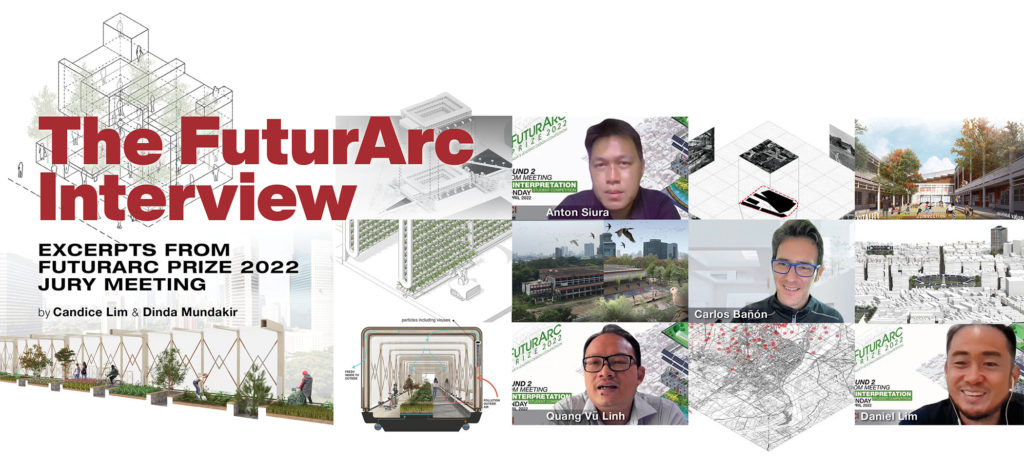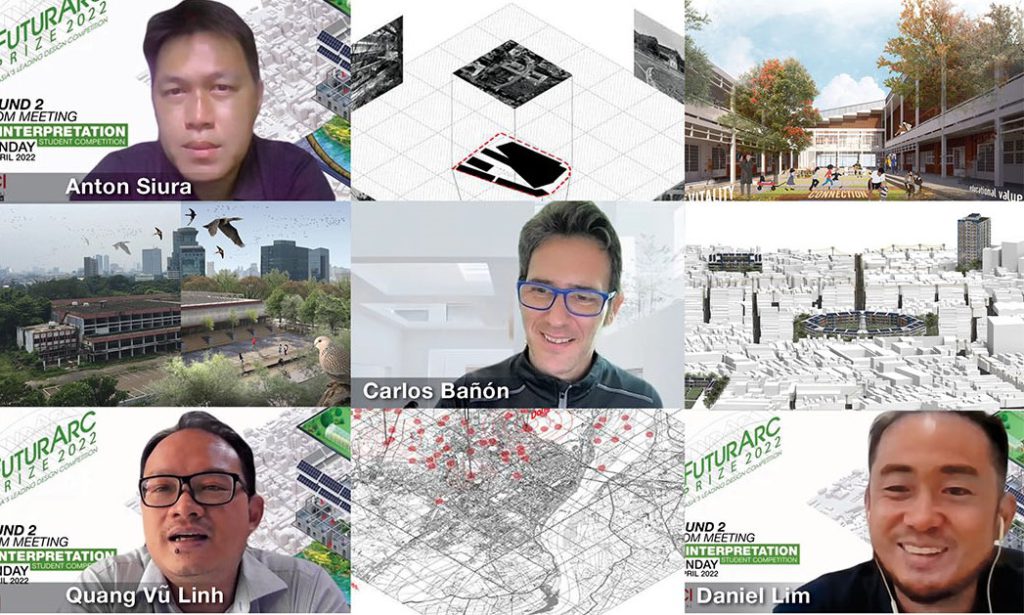Practicality or Concept: Excerpts from FuturArc Prize 2022 Jury Meeting
September 7, 2022

This year, we conducted our first-ever virtual jury meeting for FuturArc Prize, where jurors* Anton Siura, Carlos Bañón, Daniel Lim and Quang Vu Linh had a candid dialogue on the top-scoring entries as well as their views on this cycle’s theme and advice for real-life applications.
*) Kotchakorn Voraakhom was unable to make it for the meeting.
RELATED | Not Just Buildings: Round-Table Discussion with FAP 2022 Jurors
ENTRIES DISCUSSION
First Place: A Chronographic Blueprint
Anton Siura (AS): Basically, I chose this as the first one with full marks. Obviously, I would want to listen to Daniel’s feedback because you’re Malaysian and you would know better than [the rest of] us about the context, history and so on. But based on the effort of this participant, [it’s clear that] he did a lot of research, from the site history and the execution to the detailed programmes—the entry is very well-crafted. So, if this entry goes to a stakeholder or someone to develop the plan further, they have almost everything they need, with of course additional input from other expertise.
I also did some research to have another look at this project and to find out what this Valley of Hope is; how the local architects tried to preserve the buildings with the place’s history; how the buildings looked like in the past, etc. What is interesting about the entry is the way the entrant converts this space that is still contextual with the past, with a vision for the future as a research lab. And the graphics are absolutely unique. I think we seldom see this type of graphics from current architects or designers—this entrant has a distinct way of conveying the message with simple graphics plus detailed analysis. That’s why this entry has a perfect score from me.

Daniel Lim (DL): I have to agree with everything that has been brought up; definitely there was good planning and a good showcase of adaptive reuse. I do think that it was a good idea, but I was also looking for innovation, as in new ideas. Besides the adaptive reuse of it, this is actually a kampung-life approach for what used to be a lepers’ centre, which is quite the norm—there are definitely a lot of similar projects in that area or even in the state. So, in terms of innovation, I didn’t rate this entry that high mainly for it.
But in terms of compliance with adaptive reuse and in going through the processes, I definitely agree with the other jurors. So, I don’t have an objection if this is going to be the winner. I think that makes sense as well. But again, my scoring was because I’ve seen a lot of such ideas implemented and there are quite a few case studies around.
A part of the judging criteria was replicability, which implies that an entry is to be realised.
Candice Lim (CL): It’s important that as jurors, you give your honest feedback about these entries because they will learn from it, especially for this cycle’s theme where we are not asking them about a futuristic vision that will happen 20 or 30 years down the road; we are asking them about a current site that is already abandoned, underused or underutilised.
So, if a particular entry really has a strong case to put forward, and if somehow, in their conviction, they want to push this towards realisation, your feedback will be something that they will rely on in order to make this a reality, which is not impossible. Because the site already exists; they’re not coming up with a new island or something.
A part of the judging criteria was replicability, which implies that an entry is to be realised, so the fact that this is a strong entry could mean it could come to bear one day. Of course, it depends on whether they could sell this idea to whoever owns the land.
Second Place: Biodivercity
Carlos Bañón (CB): I find it very relevant, the position of the place and the alignment of the change of views. The idea is quite exciting to use those facilities in such a way, and then also to look at solving a certain problem that embraces other species—not just for humans but the whole ecosystem and how to design for them. I also like the parts where they try to respect the materiality, or at least, in a way that is respectful to the site—that is also one of the entry’s values, where they are not doing some big transformation visually, but something subtle yet practical at the same time. I find it a solid candidate.
Quang Vũ Linh (QVL): This scheme is very interesting to me from the beginning, although I did not score it high, frankly speaking, because I looked at it from an architectural point of view, not landscape architecture. After hearing the comments from the other jurors, I think that in terms of biodiversity, things have changed a lot in terms of urban context, especially for Indonesia. But I think it would be nicer if they could have more solutions for the existing building on-site, rather than just simply putting some greenery, biodiversity and birds, etc. Overall, it’s a good scheme in terms of images and the landscape aspect.

Third Place: Revival Waste
QVL: This is a very practical project. It can easily transform the factory to become something that’s very useful for people. The way they have changed the interiors with the new proposed programme makes sense; bringing daylighting into the building is quite nice too. All the interior renderings are attractive. In Vietnam, we haven’t seen anything like this in reality. So, it would be great to see something like that in real life, and I think it could be a very good case study for the local authorities to utilise existing buildings to be more useful for the local people.
AS: I didn’t put this entry in my top three, although it’s a good project. There are a lot of similar kinds of approaches to reusing old buildings, which is always about agriculture, or how to treat garbage.
But we need to look deeper into the context of the site: is it the right place to manage rubbish? Imagine all the trucks coming and going from this building. The second point is ventilation. When you put waste pre-production into a very centralised building without a lot of air, what will be the impact in terms of the risk of pollution, the smell, and so on?

And when we look at the image here of people sitting in the amphitheatre and talking while there’re a lot of technical things going on with the waste production process, will this happen? So, my concern is the location and the type of building; whether it’s suitable for this idea, because probably this can be executed in a more decentralised building that has a lot of outdoor space.
[This is an excerpt. Subscribe to the digital edition or hardcopy to read the complete article.]
RELATED: A Chronographic Blueprint



Read more stories from FuturArc 3Q 2022 Green Awards: Reinterpretation!

To read the complete article, get your hardcopy at our online shop/newsstands/major bookstores; subscribe to FuturArc or download the FuturArc App to read the issues!
Previously Published FuturArc Interview
Contact us at https://www.futurarc.com/contact-us for older interviews.

